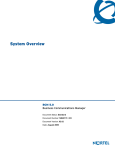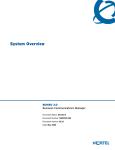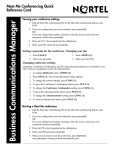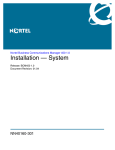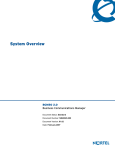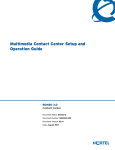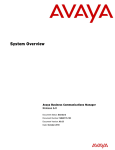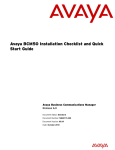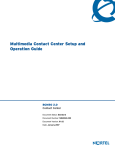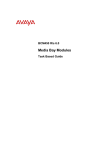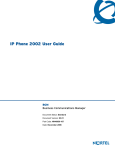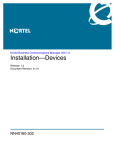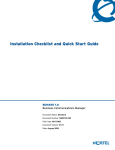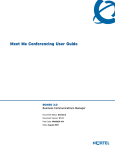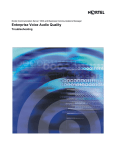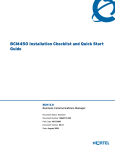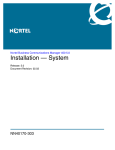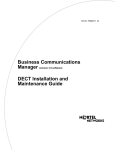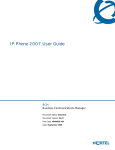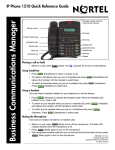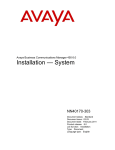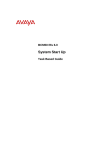Download Avaya Nortel Business Communications Manager 450 1.0 System Overview
Transcript
System Overview BCM450 1.0 Business Communications Manager Document Status: Standard Document Number: NN40160-103 Document Version: 01.01 Date: August 2008 Copyright © 2008 Nortel Networks. All Rights Reserved The information in this document is subject to change without notice. The statements, configurations, technical data, and recommendations in this document are believed to be accurate and reliable, but are presented without express or implied warranty. Users must take full responsibility for their applications of any products specified in this document. The information in this document is proprietary to Nortel Networks. Trademarks Nortel, the Nortel logo, and the Globemark are trademarks of Nortel Networks. Microsoft, MS, MS-DOS, Windows, and Windows NT are trademarks of Microsoft Corporation. All other trademarks and registered trademarks are the property of their respective owners. Contents 3 Contents Chapter 1: Getting started . . . . . . . . . . . . . . . . . . . . . . . . . . . . . . . . . . . . . . . . . . . 5 About this guide . . . . . . . . . . . . . . . . . . . . . . . . . . . . . . . . . . . . . . . . . . . . . . . . . . . . . . . . . . . 5 Audience . . . . . . . . . . . . . . . . . . . . . . . . . . . . . . . . . . . . . . . . . . . . . . . . . . . . . . . . . . . . . . . . 5 Acronyms . . . . . . . . . . . . . . . . . . . . . . . . . . . . . . . . . . . . . . . . . . . . . . . . . . . . . . . . . . . . . . . . 5 Related publications . . . . . . . . . . . . . . . . . . . . . . . . . . . . . . . . . . . . . . . . . . . . . . . . . . . . . . . 6 Chapter 2: System overview . . . . . . . . . . . . . . . . . . . . . . . . . . . . . . . . . . . . . . . . . 9 BCM450 hardware . . . . . . . . . . . . . . . . . . . . . . . . . . . . . . . . . . . . . . . . . . . . . . . . . . . . . . . . . 10 BCM450 main unit . . . . . . . . . . . . . . . . . . . . . . . . . . . . . . . . . . . . . . . . . . . . . . . . . . . . . . 10 Additional BCM450 hardware . . . . . . . . . . . . . . . . . . . . . . . . . . . . . . . . . . . . . . . . . . . . . 11 BCM450 physical dimensions . . . . . . . . . . . . . . . . . . . . . . . . . . . . . . . . . . . . . . . . . . . . . 11 BCM450 physical interfaces . . . . . . . . . . . . . . . . . . . . . . . . . . . . . . . . . . . . . . . . . . . . . . 12 LED strategy . . . . . . . . . . . . . . . . . . . . . . . . . . . . . . . . . . . . . . . . . . . . . . . . . . . . . . . . . . 13 BCM450 expansion cabinet and media bay modules . . . . . . . . . . . . . . . . . . . . . . . . . . . . . . 14 Mounting kits . . . . . . . . . . . . . . . . . . . . . . . . . . . . . . . . . . . . . . . . . . . . . . . . . . . . . . . . . . . . . 15 Telephony features . . . . . . . . . . . . . . . . . . . . . . . . . . . . . . . . . . . . . . . . . . . . . . . . . . . . . . . . 15 IP telephony features . . . . . . . . . . . . . . . . . . . . . . . . . . . . . . . . . . . . . . . . . . . . . . . . . . . 15 BCM450 features . . . . . . . . . . . . . . . . . . . . . . . . . . . . . . . . . . . . . . . . . . . . . . . . . . . . . . . . . . 16 New features . . . . . . . . . . . . . . . . . . . . . . . . . . . . . . . . . . . . . . . . . . . . . . . . . . . . . . . . . . 16 Capacity increases . . . . . . . . . . . . . . . . . . . . . . . . . . . . . . . . . . . . . . . . . . . . . . . . . . 16 Set templates . . . . . . . . . . . . . . . . . . . . . . . . . . . . . . . . . . . . . . . . . . . . . . . . . . . . . . 17 Parameter renumbering . . . . . . . . . . . . . . . . . . . . . . . . . . . . . . . . . . . . . . . . . . . . . . 18 Dynamic Device Configuration . . . . . . . . . . . . . . . . . . . . . . . . . . . . . . . . . . . . . . . . . 18 WLAN 6120 and 6140 handsets . . . . . . . . . . . . . . . . . . . . . . . . . . . . . . . . . . . . . . . . 18 System reset button . . . . . . . . . . . . . . . . . . . . . . . . . . . . . . . . . . . . . . . . . . . . . . . . . 19 Existing features . . . . . . . . . . . . . . . . . . . . . . . . . . . . . . . . . . . . . . . . . . . . . . . . . . . . . . . 19 Power On Self Test logging . . . . . . . . . . . . . . . . . . . . . . . . . . . . . . . . . . . . . . . . . . . . 19 Security . . . . . . . . . . . . . . . . . . . . . . . . . . . . . . . . . . . . . . . . . . . . . . . . . . . . . . . . . . . 20 Platform accounts . . . . . . . . . . . . . . . . . . . . . . . . . . . . . . . . . . . . . . . . . . . . . . . . . . . 21 User ID length . . . . . . . . . . . . . . . . . . . . . . . . . . . . . . . . . . . . . . . . . . . . . . . . . . . . . . 21 Additional supported features . . . . . . . . . . . . . . . . . . . . . . . . . . . . . . . . . . . . . . . . . . . . . 22 R2MFC MBM support . . . . . . . . . . . . . . . . . . . . . . . . . . . . . . . . . . . . . . . . . . . . . . . . 22 Network Configuration Manager support for BCM450 . . . . . . . . . . . . . . . . . . . . . . . 23 Analog Direct Inward Dial Media Bay Module . . . . . . . . . . . . . . . . . . . . . . . . . . . . . 23 8x16 Media Bay Module . . . . . . . . . . . . . . . . . . . . . . . . . . . . . . . . . . . . . . . . . . . . . . 23 Next generation IP phones . . . . . . . . . . . . . . . . . . . . . . . . . . . . . . . . . . . . . . . . . . . . 23 SIP and H.323 interoperability . . . . . . . . . . . . . . . . . . . . . . . . . . . . . . . . . . . . . . . . . 24 Hardware inventory . . . . . . . . . . . . . . . . . . . . . . . . . . . . . . . . . . . . . . . . . . . . . . . . . . 24 Proactive voice quality monitoring . . . . . . . . . . . . . . . . . . . . . . . . . . . . . . . . . . . . . . 24 System Overview 4 Contents Ad Hoc conferencing . . . . . . . . . . . . . . . . . . . . . . . . . . . . . . . . . . . . . . . . . . . . . . . . 25 Session initiated protocol . . . . . . . . . . . . . . . . . . . . . . . . . . . . . . . . . . . . . . . . . . . . . 25 Terminal and mobility support . . . . . . . . . . . . . . . . . . . . . . . . . . . . . . . . . . . . . . . . . . 26 Global markets . . . . . . . . . . . . . . . . . . . . . . . . . . . . . . . . . . . . . . . . . . . . . . . . . . . . . 26 Support, security and servicing . . . . . . . . . . . . . . . . . . . . . . . . . . . . . . . . . . . . . . . . . . . . . . . 29 Client operating system support . . . . . . . . . . . . . . . . . . . . . . . . . . . . . . . . . . . . . . . . . . . 29 Field replaceable units . . . . . . . . . . . . . . . . . . . . . . . . . . . . . . . . . . . . . . . . . . . . . . . . . . 29 BCM450 management . . . . . . . . . . . . . . . . . . . . . . . . . . . . . . . . . . . . . . . . . . . . . . . . . . . . . . 30 Ease of installation . . . . . . . . . . . . . . . . . . . . . . . . . . . . . . . . . . . . . . . . . . . . . . . . . . . . . 30 Startup profile . . . . . . . . . . . . . . . . . . . . . . . . . . . . . . . . . . . . . . . . . . . . . . . . . . . . . . 30 Remote management accessibility . . . . . . . . . . . . . . . . . . . . . . . . . . . . . . . . . . . . . . . . . 30 On-box and device manageability features . . . . . . . . . . . . . . . . . . . . . . . . . . . . . . . . . . . 31 Log management . . . . . . . . . . . . . . . . . . . . . . . . . . . . . . . . . . . . . . . . . . . . . . . . . . . . . . 32 Set-based administration . . . . . . . . . . . . . . . . . . . . . . . . . . . . . . . . . . . . . . . . . . . . . . . . 32 Business Element Manager . . . . . . . . . . . . . . . . . . . . . . . . . . . . . . . . . . . . . . . . . . . . . . 32 Business Element Manager administration interface . . . . . . . . . . . . . . . . . . . . . . . . 33 Software updates . . . . . . . . . . . . . . . . . . . . . . . . . . . . . . . . . . . . . . . . . . . . . . . . . . . 34 Keycodes . . . . . . . . . . . . . . . . . . . . . . . . . . . . . . . . . . . . . . . . . . . . . . . . . . . . . . . . . . . . . 34 Network Configuration Manager . . . . . . . . . . . . . . . . . . . . . . . . . . . . . . . . . . . . . . . . . . . 35 Microsoft Vista operating system . . . . . . . . . . . . . . . . . . . . . . . . . . . . . . . . . . . . . . . . . . 35 BCM450 applications . . . . . . . . . . . . . . . . . . . . . . . . . . . . . . . . . . . . . . . . . . . . . . . . . . . . . . . 37 Meet-Me Conferencing . . . . . . . . . . . . . . . . . . . . . . . . . . . . . . . . . . . . . . . . . . . . . . . . . . 37 Mailbox Manager . . . . . . . . . . . . . . . . . . . . . . . . . . . . . . . . . . . . . . . . . . . . . . . . . . . . . . . 37 Mailbox Manager features . . . . . . . . . . . . . . . . . . . . . . . . . . . . . . . . . . . . . . . . . . . . 38 CallPilot . . . . . . . . . . . . . . . . . . . . . . . . . . . . . . . . . . . . . . . . . . . . . . . . . . . . . . . . . . . . . . 40 Features included with CallPilot . . . . . . . . . . . . . . . . . . . . . . . . . . . . . . . . . . . . . . . . 40 CallPilot options . . . . . . . . . . . . . . . . . . . . . . . . . . . . . . . . . . . . . . . . . . . . . . . . . . . . . . . 41 Message networking . . . . . . . . . . . . . . . . . . . . . . . . . . . . . . . . . . . . . . . . . . . . . . . . . 41 Fax . . . . . . . . . . . . . . . . . . . . . . . . . . . . . . . . . . . . . . . . . . . . . . . . . . . . . . . . . . . . . . 41 Unified messaging . . . . . . . . . . . . . . . . . . . . . . . . . . . . . . . . . . . . . . . . . . . . . . . . . . 41 Intelligent Contact Center . . . . . . . . . . . . . . . . . . . . . . . . . . . . . . . . . . . . . . . . . . . . . . . . 42 Multimedia Contact Center . . . . . . . . . . . . . . . . . . . . . . . . . . . . . . . . . . . . . . . . . . . . . . . 42 Local Area Network Computer Telephony Engine . . . . . . . . . . . . . . . . . . . . . . . . . . . . . 43 Call Detail Recording . . . . . . . . . . . . . . . . . . . . . . . . . . . . . . . . . . . . . . . . . . . . . . . . . . . 43 Personal Call manager . . . . . . . . . . . . . . . . . . . . . . . . . . . . . . . . . . . . . . . . . . . . . . . . . . 43 BCM compatibility matrix . . . . . . . . . . . . . . . . . . . . . . . . . . . . . . . . . . . . . . . . . . . . . . . . . . . . 44 NN40160-103 5 Chapter 1 Getting started About this guide This system overview gives a high-level understanding of the core capabilities and features of the Business Communications Manager 450 (BCM450) 1.0. Audience This overview is for installers, network administrators, and others who are interested in the BCM450. Acronyms Following is a list of acronyms used in this guide. Acronym Description ADID Analog direct inward dial AMIS Audio Messaging Interchange Specification APAC Asia Pacific BCM Business Communication Manager BFT Base function tray CALA Caribbean and Latin America CCR Custom call routing CDR Call Detail Recording CEC Capacity expansion card CIM Common information model CTI Computer telephony integration DDC Dynamic device configuration DMTF Distributed Management Task Force DN Directory number DTMF Dual-tone multi frequency FEM Fiber expansion module FRU Field replacable unit System Overview 6 Chapter 1 Getting started Acronym Description GASM Global Analog Station Module GATM Global Analog Trunk Module GNPS Global Network Product Support HDD Hard disk drive ICC Intelligent Contact Center ICCL ISDN call connection limit IP Internet Protocol ISDN Integrated services digital network KEM Key expansion module LAN CTE Local area network computer telephony engine MBM Media bay module MCDN Meridian customer defined network MIB Management information base MWI Message waiting indication NCM Network Configuration Manager NCRI Network call redirection info OS Operating system POST Power on Self Test PSTN Public switched telephone network PVQM Proactive voice quality monitoring QoE Quality of Experience SFTP Secure File Transfer Protocol SIP Session Initiated Protocol SNMP Simple Network Management Protocol VoIP Voice over Internet Protocol VPIM Voice profile for internet mail Related publications This section provides a list of additional documents. To locate specific information, you can refer to the Master Index of BCM450 Library. Nortel Business Communications Manager 450 1.0 Installation—System (NN40160-301) Nortel Business Communications Manager 450 1.0 Installation—Devices (NN40160-302) Nortel Business Communications Manager 450 1.0 Maintenance (NN40160-503) Nortel Business Communications Manager 450 1.0 Configuration—System (NN40160-501) NN40160-103 Getting started Chapter 1 7 Nortel Business Communications Manager 450 1.0 Configuration—Devices (NN40160-500) Nortel Business Communications Manager 450 1.0 Configuration—Telephony (NN40160-502) Nortel Business Communications Manager 450 1.0 Planning and Engineering (NN40160-200) Nortel Business Communications Manager 450 1.0 Administration and Security (NN40160-601) Nortel Business Communications Manager 450 1.0 Fault and Performance Management (NN40160-701) Unified Messaging Configuration Guide (NN40080-501) CallPilot Fax Set Up and Operation Guide (NN40080-301) CallPilot Message Networking Set Up and Operation Guide (NN40090-301) Personal Call Manager User Guide (NN40020-103) Intelligent Contact Center Set Up and Operation Guide (NN40040-301) LAN CTE Configuration Guide (NN40020-602) Call Detail Recording System Administration Guide (NN40020-605) Personal Call Manger User Guide (NN40010-104) Activity Reporter Administration Guide (NN40010-627) Activity Reporter User Guide (NN40010-112) System Overview 8 Chapter 1 Getting started How to get help This section explains how to get help for Nortel products and services. Getting Help from the Nortel Web site The best way to get technical support for Nortel products is from the Nortel Technical Support Web site: www.nortel.com/support This site provides quick access to software, documentation, bulletins, and tools to address issues with Nortel products. More specifically, the site enables you to: • download software, documentation, and product bulletins • search the Technical Support Web site and the Nortel Knowledge Base for answers to technical issues • sign up for automatic notification of new software and documentation for Nortel equipment • open and manage technical support cases Getting Help over the phone from a Nortel Solutions Center If you don’t find the information you require on the Nortel Technical Support Web site, and have a Nortel support contract, you can also get help over the phone from a Nortel Solutions Center. In North America, call 1-800-4NORTEL (1-800-466-7835). Outside North America, go to the following Web site to obtain the phone number for your region: www.nortel.com/callus Getting Help from a specialist by using an Express Routing Code To access some Nortel Technical Solutions Centers, you can use an Express Routing Code (ERC) to quickly route your call to a specialist in your Nortel product or service. To locate the ERC for your product or service, go to: www.nortel.com/erc Getting Help through a Nortel distributor or reseller If you purchased a service contract for your Nortel product from a distributor or authorized reseller, contact the technical support staff for that distributor or reseller. NN40160-103 9 Chapter 2 System overview The Business Communications Manager 450 Release 1 (BCM450 1.0) provides private network and telephony management capability to small- and medium-sized businesses. BCM450 1.0 is a complete, converged voice, and feature-rich business telephony applications solution for small business and small enterprise branch offices. BCM450 gives you the features and applications of traditional small office PBX and key systems plus the converged value of IP. BCM450 1.0 supports software functionality and enhancements previously supported by BCM50 3.0 and introduces increased platform capacities over BCM50 3.0 and BCM400 platforms by scaling to 300 users. BCM450 provides increased capacity for lines, trunks, TDM, IP, and conferencing, as well as increased storage for voice mail. This release also introduces new hardware modifications. This release of BCM450 introduces the following enhancements: • • • • • • • • • • • • enhanced base function tray (BFT) capacity expansion card (CEC) new 80 Gigabyte hard drive with easier access for field replacement simplification of the LED strategy reset button increased capacity for IP sets, IP trunks, conference participants, and voice mail storage new WLAN Handsets 6120 and 6140 set templates parameter renumbering Dynamic Device Configuration (DDC) integration of Advanced Productivity Pack (APPP) NCM4.0 Release Pack 3 For more information, see “BCM450 features” on page 16. System Overview 10 Chapter 2 System overview BCM450 hardware BCM450 (as shown in Figure 1) features a new base function tray. Figure 1 BCM450 hardware—front view MBMs Base function tray For more information about BCM450 hardware, see Nortel Business Communications Manager 450 1.0 Installation—System (NN40160-301). BCM450 main unit The primary hardware component of your BCM450 system is the main unit. Each BCM450 system must have one main unit. The main unit houses the base function tray (BFT) and has four slots for media bay modules (MBM). You can connect your BCM450 system directly to a power source or through an optional uninterruptible power supply (UPS). The BCM450 main unit provides call processing functions. The BFT, which is housed in the main unit, provides four connections for auxiliary equipment (auxiliary ringer, page relay, page output, and music source). The BCM450 main unit has no router, but it has two LAN ports and one OAM port. The main unit includes four slots for MBMs, and supports up to one fiber expansion module (FEM) MBM for connecting N* expansion modules. For more information the FEM, refer to Nortel Business Communications Manager 450 1.0 Installation—System (NN40160-301). NN40160-103 System overview Chapter 2 11 A main unit contains the following field-replaceable units: • • • • • • cooling fan power supply unit base function tray (BFT) hard disk drive (HDD) up to four MBMs optional capacity expansion card (CEC) Additional BCM450 hardware In addition to a main unit, the BCM450 system can include a BCM450 expansion cabinet. An expansion cabinet connects to the main unit and provides additional functionality through one or more installed media bay modules (MBM). The BCM450 expansion cabinet accommodates the MBMs used by other BCM platforms. The BCM450 main unit can support one expansion cabinet. For more information, see “BCM450 expansion cabinet and media bay modules” on page 14. The BCM450 is available with the following mounting options: • • • rack-mount (standard 19-inch rack) stand-alone (feet included); wall-mount (optional wall-mount bracket available separately) The wall-mount bracket is an inexpensive bracket for mounting the BCM450 or expansion cabinet to a wall; for more information, see “Mounting kits” on page 15. You can rack-mount a maximum of four BCM450 systems directly into a standard 19-inch rack. For more information, see “Mounting kits” on page 15. BCM450 physical dimensions The following table describes the physical dimensions of the BCM450 main unit and expansion cabinet. Dimensions BCM450 main unit BCM450 expansion cabinet Height 7 in. (17.8 cm) 7 in. (17.8 cm) Width 17.5 in. (44.5 cm) 17.5 in. (44.5 cm) Depth 18 in. (45.8 cm) 18 in. (45.8 cm) The BCM450 main unit and expansion cabinet design features include in following components: • • • rubber feet that allow unit installation on a desktop or a shelf optional wall-mount bracket kit optional rack-mount shelf System Overview 12 Chapter 2 System overview BCM450 physical interfaces Figure 2 map the physical interfaces of the BCM450 hardware. Figure 2 BCM450 physical interfaces and LEDs OAM port (port 0) LAN port (port 1) LAN port (port 2) Music source Auxiliary ringer Page relay Page output Power LED Status LED HDD LEDs USBx2 COM port DS256 expansion port Your BCM450 is equipped with the following interfaces: • • • • • • • • An RJ-45 jack used to connect a computer running administration software, such as Element Manager, to the main unit. Two RJ-45 jacks used to connect the customer LAN to the main unit. Two USB 2.0 (compatible with USB 1.1) ports used to connect USB storage devices or the data interfaces for an uninterruptible power supply (UPS) to the main unit. One DS256 jack to connect the BCM expansion cabinet to the BCM450 main unit. One auxiliary ringer jack to control the cadence of an auxiliary ringer (customer supplied). A page relay jack connects a floating relay contact pair. The BCM450 system uses this jack to control the external paging amplifier. A page output port allows generated voice paging signal to an external paging amplifier (customer supplied). Music on hold input supported either through the front panel jack. You can extend the capacity of your system by using the optional “BCM450 expansion cabinet and media bay modules” on page 14. NN40160-103 System overview Chapter 2 13 LED strategy BCM450 offers a simplified LED strategy, reducing the status LEDs to two: the Power LED and the Status LED (see Figure 2 on page 12). The Power and Status LEDs provide visual status for the platform areas shown in Table 1. Table 1 LED states with descriptions of LED combinations Power LED Status LED LED combinations description Start-up sequence Solid yellow Solid yellow Power is applied to the system. Solid yellow Off POST (Power On Self Test) (duration 9 seconds) Solid yellow Solid yellow System initialization (duration 14 seconds) Solid green Solid yellow Kernel initialization (duration 8 seconds) or Safe OS Solid green Blinking green Services initialization (duration 1 minute) Solid green Solid green System running Solid green Solid red Services initialization FAILURE Safe Mode start-up ssquence Solid red Solid green System is running with manufacturing settings enabled Solid red Solid red System is running in Software Reset mode Solid red Blinking yellow System is unning in Configuration Reset mode Shutdown sequence or FAILURE Solid green Blinking yellow Graceful shutdown in progress (trigger: Element Manager or UPS) Off Solid red Graceful shutdown completed. Solid red Blinking yellow Overheat detected; thermal shutdown completed Solid red Solid red Power spike or rail power fluctuation detected Blinking red Solid red Rail power fluctuation; power monitor shutdown completed Solid yellow Solid red Power spike shutdown completed (temperature and rail power OK) Off Off No power; system is shut down (power cable is disconnected) Start-up profile (LED combinations seen only during initial system install or staging) Blinking yellow Blinking yellow Start-up profile executing Solid green Solid green Start-up profile successfully applied Blinking yellow Blinking red Start-up profile FAILURE System Overview 14 Chapter 2 System overview BCM450 expansion cabinet and media bay modules You can expand BCM450 trunk and station capacity by connecting an external BCM450 expansion cabinet. The expansion port on the BCM450 is enabled through keycodes. The expansion cabinet integrates easily with the BCM450 and is easy to integrate and install using the wall-mount and rack-mount accessories. The expansion cabinet connects to the BCM450 using an RJ-45 CAT5 cable and uses its own external power supply, both of which are provided with the expansion cabinet. An expansion cabinet can support six media bay module (MBM) and, the same modules currently supported in the BCM products. BCM450 supports the following MBMs: • • • • • • • • • • • • • • • NN40160-103 4x16 Combo (4 analog trunks, 16 digital stations) — North America only 8x16 combo (8 analog trunks, 16 digital stations) ADID4 and ADID8 modules — North America only ASM8+ (8-port analog station interface) — North America only CTM4 (4-port CLID trunk module) — North America only CTM8 (8-port CLID trunk module) — North America only DTM (digital trunk module) BRI (ISDN Basic Rate trunk module) DSM16+ (16-port digital station module) DSM32+ (32-port digital station module) GATM4 (4-port global analog trunk module) GATM8 (8-port global analog trunk module) GASM8 (8-port global analog station module) R2MFC FEM System overview Chapter 2 15 Figure 3 BCM450 system with expansion cabinet Expansion cabinet Main unit Mounting kits Businesses can have a range of physical environments in which the system must be installed. The BCM450 has optional accessories you can use to tailor the installation to the needs of the location. For more information on mounting options, mounting equipment, and procedures, refer to Nortel Business Communications Manager 450 1.0 Installation—System (NN40160-301). Telephony features BCM450 provides a full set of telephony features that can respond to the various requirements of your business. BCM450 supports the following features and components: • • • • full set of base telephony features consistent with the BCM portfolio Business Series Telephones including Doorphone analog station terminals, including phones and fax machines IP phones, such as IP 2000 series, IP 1100 series, IP 1200 series phones, and WLAN IP handsets IP telephony features BCM450 offers the complete range of IP telephony features currently provided in the BCM450 product line: • • • G.711 and G.729 codecs with echo cancellation H.323 VoIP trunking SIP VoIP trunking System Overview 16 Chapter 2 System overview • • Nortel Voice Networking (MCDN) support on both H.323 and SIP trunks T.38 and G.711 Fax over IP Note: Support for desktop clients includes Nortel IP telephone portfolio including IP Phone 1210, IP Phone 1220, IP Phone 1230, IP Phone 2001, IP Phone 2002, IP Phone 2004, IP Phone 2007, IP Phone 1110, IP Phone 1120e, IP Phone 1140e, IP Audio Conference Phone 2033. Support for soft-clients is offered through the IP 2050 software phones that extend voice services to mobile and home-based employees over the Internet. BCM450 features BCM450 features are summarized in two sections, "New features" and “Existing features” on page 19. New features The following list indicates the new features introduced with BCM450 1.0. • • • • • • “Capacity increases” on page 16 “Set templates” on page 17 “Parameter renumbering” on page 18 “Dynamic Device Configuration” on page 18 “WLAN 6120 and 6140 handsets” on page 18 “System reset button” on page 19 Capacity increases Table 2 shows the areas of the BCM450 platform that have increased capacity over previous BCM and BCM50 platforms. The base platform supports 100 stations, 48 trunk channels (with the exception of E1 trunks, which support two DTM MBMs for a total of 60 E1 trunks.), 64 conference participants, and 2 fax ports. BCM450 supports the complete range of IP telephony capability offered by existing BCM products. These features are enabled through keycodes and require a CEC to be installed to allow maximum capacities: • • • NN40160-103 VoIP Gateway (H.323 or SIP): up to 130 VoIP trunks VoIP Telephony Clients: up to 300 VoIP Telephony clients, that support the IP Softphone 2050 client, the Mobile Voice Client 2050 and the complete range of Nortel IP phones SIP Gateway trunks: up to 130 SIP trunks System overview Chapter 2 17 Table 2 BCM450 capacity increases Feature Value Digital sets support 300 total users of any mix of analog, IP, and digital sets (with CEC installed) IP sets support Up to 300, depending on other set allocation (with CEC installed) Conference participants 124 (Ad hoc or Meet Me participants) Unified Messaging seats 300 Voice mail storage 400 hours (with CEC installed) Fax up to 8 ports Table 3 Device types maximums Device type Value Maximum TDM set DNs 300 Maximum number of IP set DNs 300 Maximum number of application DNs 115 Maximum number of ISDN DNs 60 Maximum number of target lines (target line numbering starts at line 361) 550 Maximum number of TDM trunks (analog and digital physical trunks) 130 Maximum number of IP trunks 130 Maximum conference parties 124 Maximum conferences 64 Set templates Element Manager administrators can use this feature to configure multiple telephone sets by propagating the information and modifications through the template. You can combine a number of set parameter settings into a template. You can add a number of set models to a template for buttons programming. You can also include voice mail box as part of the template. This creates a voice mailbox for the sets that are associated with a template. You can then assign those parameters to appropriate sets on the BCM. You can use the template import and export feature or the BCM Backup and Restore feature to achieve template portability. You can create templates in three ways: • • • as an original template from a set (DN) from an existing template, including the default DID or PBX templates System Overview 18 Chapter 2 System overview Parameter renumbering Use the Element Manager to quickly renumber specific parameters in the sets and lines configuration. The following list shows the parameters that you can renumber using a template: • • • • • • DNs Public OLI Private OLI Target Line Assignments Public Received Digits Private Received Digits When you renumber DNs, all related parameters, such as the DN name, also change to match the DN. When you renumber DNs and the set has a voice mailbox, it is possible to also renumber the mailbox. In this case, the mailbox is deleted and a new one is created using the same parameters that existed for the old mailbox, with the exception of the extension. The extension field is set to the new DN created by renumbering process. Dynamic Device Configuration With the hardware capacity requirements of the new BCM 450 1.0, the new BCM450 platform must support a different method a assigning directory numbers (DN) and line numbers to devices and hardware on the platform. On previous platforms all possible DNs and line numbers were preconfigured, regardless of the actual configured hardware on a system. For BCM 450 1.0, DN and line number allocation and assignment must be provisioned When a hardware device is installed on the BCM450, you must configure that device to assign the necessary DNs and lines and other associated resources to make that device operational. To remove a device, you must deconfigure it first. WLAN 6120 and 6140 handsets BCM450 1.0 supports the new WLAN 6120 and 6140 phone models. For more information on these new handsets, refer to WLAN 2210/2211/2212 Handset Installation and Configuration Guide Addendum (NN40050-400) and WLAN 2210/2211/2212 Handset User Guide Addendum (NN40050-401). NN40160-103 System overview Chapter 2 19 System reset button The BCM450 R1 system is equipped with a reset button which reboots and makes available a user interface to invoke a configuration reset (Level 1) or software reset (Level 2). After pressing the reset button, connect a PC to the local OAM BCM port (Ethernet or serial), and log on to the system (while it is running the Safe OS mode). Enter the command for level 1 or level 2 reset. Alternatively, you can decide not to do a Level 1 or Level 2 reset and simply reboot the system in normal mode. For more information on system resets, refer to Nortel Business Communications Manager 450 1.0 Administration and Security (NN40160-601). Existing features In addition to features introduced in BCM450 1.0, BCM450 includes features that are present in previous BCM platforms such as BCM50 3.0 and BCM 4.0. These include • • • • • • • • • • • • • “Security” on page 20 “R2MFC MBM support” on page 22 “Network Configuration Manager support for BCM450” on page 23 “Analog Direct Inward Dial Media Bay Module” on page 23 “8x16 Media Bay Module” on page 23 “Next generation IP phones” on page 23 “SIP and H.323 interoperability” on page 24 “Hardware inventory” on page 24 “Proactive voice quality monitoring” on page 24 “Ad Hoc conferencing” on page 25 “Session initiated protocol” on page 25 “Terminal and mobility support” on page 26 “Global markets” on page 26 Power On Self Test logging Power On Self Test (POST) is a set of hardware tests occurs early in the system boot cycle. The data from these tests are captured and published to the standard log system when the boot cycle is complete. When the BCM450 is powered up, it goes through a number of POST to validate the system. Results from the POST are currently displayed on the serial port in real time. The solution provided here is a complete solution for making POST results available on the main file system. System Overview 20 Chapter 2 System overview Security BCM450 1.0 suports the following security enhancements introduced in previous BCM platforms. Last failed login time The last failed login time information is added to the current user panel in Element Manager and displays the last time the login was attempted and failed. Web access on Secure Socket Layer Version 3 BCM450 1.0 sets the default Secure Socket Layer (SSL) protocol to SSLv3 for Web access. User account access management This feature significantly improves BCM user-account access management by enhancing password, session, account authentication, and access-management. These improvements align the BCM with the security enhancements introduced with BCM50 and add incremental capabilities. Password Management and Policy Enhancements include • Minimize the vulnerability of passwords — password characteristics are now more stringent (length, criteria) — password aging, history and change notification added — forced password change on initial login — password storage hashing with Secure Hashing Algorithm 1 (SHA1) Session Management Enhancements minimizes the vulnerability of logged-on sessions for idle session time outs. Account Management includes • Minimize the vulnerability of User IDs — Automatic disabling of unused accounts — Set-based administration requires user ID and password Account User ID Access Privilege Management includes the logged-on user ID session and access display. These enhancements to user-account access management provide a secure BCM access environment, which makes it difficult for a malicious user to gain access to a BCM. BCM owners can enforce secure account-access controls to the BCM to ensure secure BCM management and to increase protection against potential vulnerabilities. NN40160-103 System overview Chapter 2 21 Secure interface and audit logging This feature enhances interface security by adding secure access controls, security audit logs (configchange.systemlog), and system activity by User ID, date, and time. Secure Interface Access and Communications Controls provide • • • • • support for Secure Copy (SFTP) SSH encrypted file transfers support for Simple Network Management Protocol (SNMP) v2 and v3, including encryption provided with v3 BCM owner control of Nortel technical support access use of digital signatures and enhanced tamper detection to ensure trusted sources for software upgrades (patches and software release upgrades) ability to test the system ability to generate alarms and logs, including system security alarms and logs Audit log tracks critical changes to the system and the logon attempts, including • • • last successful login identification and interface last failed login attempt and total failed logons since last successful logon configuration change log to track configuration changes to system by user ID With audit logging of long attempts, the BCM user can track security violation attempts and determine further action. If you suspect a user ID security breach as a result of system configuration changes, the audit logging of configuration changes provides traceability to user IDs and interfaces. An overall increase in security you have with effective logging capabilities for Audit Trail logs, Alarm logs and Configuration Change logs. If you require improved interface access and communications security for alarm, log, and file transfers, you can use these security enhancements. As well, you can audit and identify the critical system changes that specific users initiate. Platform accounts Platform accounts are integrated accounts that allow access to Element Manager and other functions based on privileges. The maximum number of accounts is increased to 280 active accounts for each BCM. User ID length The maximum character length for the user ID is 128 characters. System Overview 22 Chapter 2 System overview Additional supported features The following table summarizes some of the existing BCM features and capabilities that are supported by BCM450 but that were introduced and supported in previous BCM platforms. For new features and capabilities introduced with BCM450 1.0, see “New features” on page 16. BCM450 existing features Core Telephony • • • • • • • Digital Mobility Doorphone Ad Hoc Conferencing New Zealand, Mexico, Poland profile updates GASM Poland and Australia CLIDGATx (Bahrain, Ireland, Hong Kong, and Peoples Republic of China) Modem answer on CLID feature Meet Me Conferencing IP Telephony • • • • • • • • • • WLAN IP Phones IP Phone 2000 series phones IP KEM IP Phone 1100 series phones IP Phone 1200 series phones SIP trunk features H323 Interop (SN10, SN11, SE09, SE10) SIP/H323 Interop (CS1K 4.5/5.0/5.5, MCS5100 3.5 and 4.0) IP Set Firmware SIP/H323 Interop (BCM 4.0 and BCM 3.7) Management • • • • • PVQM Citrix of Element Manager Remote and Scheduled Upgrade NCM support ISDN Dial-up Data and Security • DHCP Server support for IP Phones and other devices Applications • • • • • • Intelligent Contact Center Reporting for Contact Center IP Music on Hold MCDN TAT Multimedia Contact Center Hospitality Platform • • 8x16 MBM ADID MBM (North America only) R2MFC MBM support BCM450 supports the R2MFC MBM in selected Caribbean and Latin America (CALA) and APAC countries. See the country matrix in “Global markets” on page 26. NN40160-103 System overview Chapter 2 23 Network Configuration Manager support for BCM450 Network Configuration Manager (NCM) support for BCM450 is delivered through Release Pack 3. The product is branded NCM 4.0 Release Pack 3, and is delivered to new customers on a new CD. For more information, see “Network Configuration Manager” on page 35. Analog Direct Inward Dial Media Bay Module BCM450 adds Analog Direct Inward Dial (ADID) Media Bay Modules (MBM) (ADID4 and ADID8) for North America, Taiwan, and Hong Kong markets. 8x16 Media Bay Module BCM450 has an 8x16 Combo MBM to deliver GATM8 plus DSM16 capability in one MBM. It requires only one expansion chassis and is available in all markets where the GATM8 or DSM16 is sold. Next generation IP phones BCM450 supports Next Generation IP phones from previous BCM platforms. PVQM, Desktop Assistant, and Business Element Manager button programming includes support for both existing sets and new sets. The following list provides the IP phone set types supported by BCM450: • • • • • • • • • • • • IP Phone 2001 IP Phone 2002 IP Phone 2004 IP Phone 2007 IP Softphone 2050 IP Audio Conference Phone 2033 IP Phone 1100 IP Phone 1120e IP Phone 1140e IP Phone 1210 IP Phone 1220 IP Phone 1230 System Overview 24 Chapter 2 System overview SIP and H.323 interoperability BCM450 matches BCM50 3.0 SIP and H.323 interoperability. For SIP support, see “Session initiated protocol” on page 25. SIP interoperability includes the following products: • • • • • CS1000 5.0 and 5.5 CS200 CVM11 MCS5100 3.5 and 4.0 BCM50 2.0 and 3.0 BCM 4.0 H.323 interoperability includes the following products: • • • • • • • CS1000 4.5, 5.0, and 5.5 CS2000 SN10, and SN11 CS2100 SE09, and SE10 MSC5100 3.5 Meridian IPT 3.01 BCM50 2.0 and 3.0 BCM 3.7 and 4.0 Hardware inventory The Business Element Manager hardware inventory panel for BCM450 and the Entity management information base (MIB) provides a complete hardware inventory view of all BCM450 hardware components to the FRU level. Proactive voice quality monitoring With the proactive voice quality monitoring (PVQM) capability, you can set call-quality thresholds for IP sets and receive an alert and if these thresholds are exceeded. You can proactively identify voice quality of experience (QoE) issues for every call. In turn, you can troubleshooting of voice-quality issues within the network. PVQM supports calls from an IP set to any other set or trunk. The measured call-quality metrics includes the following. • • • • packet loss inter-arrival jitter listening R-value RTCP round trip delay With PVQM, a system-wide summary view of threshold-violation alert occurrences is maintained. Threshold violations can be sent as alarms and used by the central AppManager VoIP performance-monitoring product from NetIQ to generate a system-wide view of the voice quality of the network and to help diagnose voice-quality issues. The alarms include extensive call-quality information in accordance with IETF RTCP-XR RFC 3611. NN40160-103 System overview Chapter 2 25 PVQM on BCM450 • • • • provides the ability to monitor the quality and integrity of IP-based voice networking is a significant differentiator in VoIP convergence network sales with its market-leading, proactive focus on every call. mitigates customer issues to determine whether the data network or the BCM is at fault when call-quality issues situations occur provides consistency in the QoE solution across Nortel enterprise call servers to facilitate mixed network deployments Ad Hoc conferencing Currently, the BCM supports three-party conferencing. Ad-Hoc Conferencing extends this capability to support multi party conferencing. Ad-Hoc conferencing • • • • provides a user interface model which is similar to the current F3 conference ensures no impact on the user’s feature button footprint (that is, no requirement exists for additional IC keys or for an additional feature key) provides the current three-party conferencing capabilities, allowing users the flexibility to have larger multi-party conferences supports up to 124 simultaneous participants on up to 62 conferences Session initiated protocol BCM supports H.323 and SIP VoIP basic call communication for BCM-to-BCM calls. Both SIP and H.323 can leverage the same features that Nortel Voice Networking (MCDN) capability provides. Existing supported SIP features include: • • • • • SIP REFER (incoming only) SIP proxy failover RFC 2833 locating SIP Servers using DNS (RFC3263) SIP Trunk Authentication T.38 and G.711 Fax over IP support The Nortel voice networking (MCDN) supported features include: • • • • • • Private Name/Number Network Call Redirection Info (NCRI) Trunk Anti-Tromboning (TAT) ISDN Call Connection Limit (ICCL) Message Waiting Indication (MWI) Trunk Route Optimization (TRO) System Overview 26 Chapter 2 System overview In enterprise network systems, the SIP feature supports private numbering plans, optimizes the use of network traffic (TAT/TRO/ICCL), and supports centralized voice mail applications (NCRI, MWI) using the SIP messaging protocol. By making these capabilities available using the SIP protocol, you can begin to transition your network to the latest standard. Terminal and mobility support The BCM450 terminal and mobility support is equivalent to that of BCM 4.0. BCM450 supports the following phones: • • • • • • • • • • IP Phone 1100 series IP Phone 1200 series phones T7406E Cordless Handset IP Audio Conference Phone 2033 IP Key Expansion Module I24 IP 1100 series key expansion module IP 1200 series key expansion module IP 12000 series key expansion module with Display DECT 4100 series handsets Digital mobility 7400 series phones For additional terminal and mobility supported devices, see the “BCM compatibility matrix” on page 44. Global markets BCM450 voice prompts, which were introduced in BCM 4.0, include Polish, Finnish, Korean, Turkish, and Czech. The following additional capabilities are available: • • addition of second dial tone for PRI/BRI — In some markets, a PBX must provide a local tone to the originating party (as opposed to the central office). — This feature adds the ability to provide the local tone. increased public received digit length from 7 to 12 digits — Some markets require more than public received digits to support dial plans. BCM450 regional bundles for APAC and EMEA are updated to include BRI keycodes to replace expansion chassis and BRI MBM where applicable. NN40160-103 System overview Chapter 2 27 The following country matrix table reflects country support for analog interfaces in BCM450. Table 4 Analog interface availability by market profile Market profile ASM/ ASM8+ GASM8 GASI CTM4/ Legacy New Legacy G4x16 GATI ASM8 CTM8 GATM4/ GATM4/ 4X16 G8x16 GATM8 GATM8 (new) Australia 9 Bahrain 9 9 9 9 9 9 9 9 9 9 9 9 9 9 9 9 9 9 9 9 Brazil 9 CALA 9 9 9 9 9 9 9 9 9 9 9 9 9 9 9 9 9 9 9 9 9 9 9 9 9 9 9 9 9 9 9 9 9 9 9 9 9 9 9 9 9 Italy 9 9 9 Malaysia 9 9 9 Canada 9 9 ADID Caribbean Global Hong Kong 9 Ireland 9 9 9 9 9 9 9 9 9 9 9 9 9 9 9 9 9 9 9 9 9 9 9 9 9 9 9 9 Russia 9 9 9 Saudi 9 9 9 Singapore 9 9 9 Mexico New Zealand North America 9 Poland 9 9 9 9 PRC 9 South Africa 9 9 9 9 Spain 9 9 9 9 9 9 9 9 9 9 9 9 9 Taiwan United Kingdom 9 9 9 9 9 9 9 System Overview 28 Chapter 2 System overview The following table lists the digital interfaces supported in each market profile. Note that the Digital Station Interface and the BRI cNIC are onboard interfaces. Table 5 Digital interface availability by market profile Market profile DSM16+/ DSM32+ Digital station interface BRI BRI cNIC DTM Australia 9 9 9 9 9 Bahrain 9 9 9 9 9 Brazil 9 9 9 9 CALA 9 9 9 9 Canada 9 9 9 9 9 Caribbean 9 9 9 9 9 Denmark 9 9 9 9 9 France 9 9 9 9 9 Germany 9 9 9 9 9 Global 9 9 9 9 9 Holland 9 9 9 9 9 Hong Kong 9 9 9 Ireland 9 9 9 9 9 Italy 9 9 9 9 9 Malaysia 9 9 Mexico 9 9 9 New Zealand 9 9 9 9 9 North America 9 9 9 9 9 Norway 9 9 9 9 9 Poland 9 9 9 9 9 PRC 9 9 9 Russia 9 9 Saudi 9 9 Singapore 9 9 South Africa 9 9 Spain 9 9 9 9 9 Sweden 9 9 9 9 9 NN40160-103 R2MFC 9 9 9 9 9 9 System overview Chapter 2 29 Table 5 Digital interface availability by market profile Market profile DSM16+/ DSM32+ Digital station interface BRI BRI cNIC DTM Switzerland 9 9 9 9 9 Taiwan 9 9 9 United Kingdom 9 9 9 R2MFC 9 9 9 For additional information about the market profile attributes for your BCM system, refer to the market profiles reference in Nortel Business Communications Manager 450 1.0 Configuration—System (NN40160-501). Support, security and servicing BCM450 provides solutions for client support, replacement parts, upgrades, and enhanced servicing. Client operating system support BCM450 supports Microsoft Windows 2000 Professional, Microsoft Windows XP Professional, Windows Vista, Citrix Metaframe XP for Element Manager, and Citrix client support equivalent to BCM 4.0. BCM applications for BCM450 support the following Vista versions: Microsoft Vista Business, Microsoft Vista Ultimate and Microsoft Vista Enterprise. For more information about BCM450 Microsoft Vista support, see “Microsoft Vista operating system” on page 35. Field replaceable units Field replacable units (FRU) include the hard disk drive, fan, memory, clock/calander battery, and UPS. For more information on replacing FRUs, see Nortel Business Communications Manager 450 1.0 Maintenance (NN40160-503). BCM450 management You can quickly and easily install, configure, and administer BCM450. These topics summarize the BCM450 management areas: • • • • • • "Ease of installation" “Remote management accessibility” on page 30 “On-box and device manageability features” on page 31 “Set-based administration” on page 32, for no-PC programming of most of the system “Business Element Manager” on page 32, interface that supports all aspects of BCM450 element management “Network Configuration Manager” on page 35, for multi element support System Overview 30 Chapter 2 System overview Ease of installation BCM450 installation is easy with innovative hardware and management tools. The simple nature of BCM450 physical installation, with the multipurpose RJ-45-based connector strategy, provides easy installation. The dedicated RJ-45 port for management access provides easy access to the unit for on-site PC-based element management tasks. You can perform all configuration using the “Business Element Manager” on page 32. Startup profile To accelerate the initial installation programming of system-level parameters, you can use the Startup Profile to quickly place the BCM450 in a basic operational state, ready to program, without having to use Element Manager or set-based administration. The Startup Profile is an easy-to-use template you can datafill using Microsoft Excel. The Startup Profile provides a quick interface to define, for example, the following parameters: • • • • • system profile including country, telephony template, and key voice mail attributes system IP parameters system-level telephony attributes to automatically create the system DNs keycode information through automated application of keycodes users and groups You fill out the template, save it to a USB storage device, and insert the memory stick into the USB port of the BCM450 during the initial startup of the system. This information is read into the BCM450 and applied during a single restart sequence. Remote management accessibility BCM450 has an integrated analog modem that can accept an incoming modem call on any BCM450 system line. You can configure the BCM450 system to have the modem automatically answer a specific line with configuration options. You can manage from BRI. Remote users can also initiate a voice call to a person or an autoattendant, who transfers the call to the modem. The analog modem also supports callback for management access to the BCM450, which can be used to support automatic dial-out on SNMP traps and automated sending of Call Detail Records (CDR) to a remote CDR collection point. The modem is also enhanced with CLID. Although Nortel does not recommend that you use the analog modem to transfer large files, the modem provides a flexible method of remote access to remotely perform all programming tasks. BCM450 also includes an ISDN interface. ISDN uses existing analog telephone wires to multiplex data into separate digital channels, which increases bandwidth. ISDN uses a single transport to carry multiple information types. Where you once required separate networks for voice, data, images, or video conferencing, it now combines into one common high-speed transport. The default configuration for ISDN dial-in is for the BCM to assign the first ISDN interface an address of 10.10.18.1 and the second client an address of 10.10.18.2. The first remote client is assigned 10.10.18.10 and the second client is assigned 10.10.18.11. The settings can be changed to have the remote clients assign themselves an address or even assign the BCM an address. NN40160-103 System overview Chapter 2 31 Finally, an administrator has the capability to disconnect a modem or ISDN call if they find that a modem or ISDN call is in progress. On-box and device manageability features BCM450 has an SNMPv3 interface that includes support for SNMP v1 and v2 for management by legacy SNMP managers. SNMPv3 delivers improved security features for SNMP device access. The BCM450 main unit supports the following versions of SNMP: • • • SNMP v1—the first implementation of SNMP; this version supports protocols such as IP SNMP v2C—provides improved efficiency and error handling SNMP v3—provides improvements in security and privacy Using the BCM450 Element Manager, you can select which versions of SNMP you want the BCM450 agent to support. Management Information Bases (MIB) provide access to the managed objects of a system and specify the format of traps. BCM450 supports these standard MIBs for remote management: • • • • • MIBII RFC 1213—second version of the MIB for use with network management protocols in a TCP/IP-based internet. This MIB includes System Group and Interfaces Group and is a baseline RFC implemented by data-networking systems. Entity MIB RFC 2737—describes managed objects used to manage multiple logical and physical entities to manage by a single SNMP agent. System Host MIB RFC 2790 MIB for to manage host systems — defines a set of objects common across many computer system architectures that are useful to manage host computers, such as memory and CPU. SmallSiteEvent MIB for traps. RFC 2261—SNMP Framework MIB. BCM450 adopts the Common Information Model (CIM) standard according to the industry standards organization Distributed Management Task Force (DMTF), which provides a modeled method to manage system-programming parameters. BCM450 uses the transport mechanism CIM operations over HTTP using XML, also referred to as CIM-XML. The BCM450 CIM-XML interface provides a consistent way to manage data on the device, whether by the BCM450 Element Manager, NCM, or third-party network or service-management applications. Log management The BCM450 logs are grouped in three categories: • operational logs • diagnostic logs • sensitive logs System Overview 32 Chapter 2 System overview Each log category contains one or more log files. You manage logs by transferring selected BCM450 log files from the BCM450 to a specified location, such as your personal computer. You can then view individual log events using the Element Manager Log Browser or your usual text editor. Set-based administration BCM450 gives you the ability to use a telephone interface to program much of the BCM450 system. Set-based administration benefits include: • • • • BCM450 installations that have no TCP/IP connectivity BCM450 installations where the installer has no on-site access to a computer installers who prefer the speed of programming using set-based administration installers who are familiar with the Norstar interface With set-based administration, you can manage • • • • • • core telephony voice mail services IP network settings keycode entry admin password change modem on or off Support is available for multiple languages, consistent with Norstar set-based administration. Business Element Manager Business Element Manager provides access to BCM450 information in an off-box management With Business Element Manager you can access any programming screen in three or fewer mouse-clicks. Programming data is enhanced in the Element Manager to quickly show all the associations between data in the form of tables. This eliminates looking in multiple places to obtain a system view of the programming. NN40160-103 System overview Chapter 2 33 Figure 4 Business Element Manager interface Element Manager runs on a PC, and the information required to draw the screens is contained locally within the client application. The only data transferred between Element Manager and the BCM450 are queries and actual data. Element Manager has familiar Microsoft Office-like capabilities, such as the ability to sort information. Element Manager integrates all the traditional BCM administration tools, including managing backups and software updates. Element Manager has an element navigation panel to organize a network of elements. You can simultaneously manage multiple elements. After you connect to an element, you can perform configuration and administration tasks. Business Element Manager administration interface The Element Manager administration management environment includes • • • • BCM450 diagnostic and maintenance tools, including access to BCM Monitor. Fault management for viewing BCM450 alarms. You can set which alarms are displayed in the Element Manager alarm browser and which alarms trigger an SNMP trap. Log management for off-box transfer of logs, including component logs and administrator logs such as alarm log, security log, configuration change log, and system log. Software management tools for software updates (for example, for corrective software) and software upgrades. System Overview 34 Chapter 2 System overview • Backup and restore. You can schedule full back ups with the option of excluding certain components which are presented in the user interface. A scheduled backup provides the ability to routinely perform a backup, which you can save on the BCM450 hard drive or transfer to an off-box destination such as network folder, FTP server, or locally attached USB storage device. For backup and restore, software management, and log management, a flexible set of source and destinations is supported along with protocols to access them. For example, you can save backups from the BCM450 to either the USB port, the Element Manager client PC (on-demand only), a shared drive available on the network, or a remote FTP server. Software updates To ensure that BCM450 maintenance costs are low, even in an environment of security and corrective content updates, the BCM450 handles software updates as follows. You can apply the Factory Backup Image with a Level 2 reset, which overwrites the current installed software on the BCM. • • • • • You can download software updates to the BCM450, either on-demand or according to a schedule, from a USB port, a shared network drive, a remote FTP server, or a client PC. Update software is automatically checked against the BCM450 software history and validated before you transfer it You can schedule the software update separately. For example, you can schedule a download for Tuesday night, but you can schedule the application for Friday at 2:00. You can program multiple software-update packages to be applied at the same time. One software-update package can include updates for multiple software components. While many software updates do not require a system restart, some software components require a restart for the update to take effect. No more than one system restart is required if one or more of the software components being updated by the software-update package requires a reboot. • Software upgrades are handled in the same way and use the same tool as software updates. • You can set up the entire software-update process for hands-off operation if the software content can either be downloaded remotely or sent and installed from the USB port. Keycodes The BCM keycode structure now includes the following capabilities: • • NN40160-103 One keycode validates all feature entitlements, which simplifies installation. You can apply keycodes in a number of ways: — through Element Manager — through set-based administration — through NCM — through a USB memory stick System overview Chapter 2 35 Network Configuration Manager Many Business Communications Manager customers already use the optional client/server-based management application Network Configuration Manager (NCM) to manage their multisite BCM200/400 network. Designed to provide a system-wide perspective for up to 2000 BCM devices, NCM is a centralized database that stores information about every Business Communications Manager device on your network. NCM for BCM450 includes centralized backup and restore management, common file distribution (for example, system greeting files), parameter configuration, and automated software-update distribution. You can manage large BCM450 networks and mixed BCM50/200/400 networks using the NCM. Microsoft Vista operating system BCM applications for BCM540 support the following Vista versions: Windows Vista Business, Windows Vista Ultimate, and Windows Vista Enterprise. BCM applications support both 32-bit and 64-bit versions of Windows Vista, except for the following limitations: • The CTE TAPI option is not supported by the 64-bit version of Windows Vista (x64). • Personal Call Manager is not supported by the 64-bit version of Windows Vista (x64). • Reporting for Contact Center is not supported by the 64-bit version of Windows Vista operating systems. • CallPilot Desktop Messaging 4.0 does not support Groupwise 7.x on Windows Vista operating systems. • The IP SoftPhone 2050 is not supported by the 64-bit version of Windows Vista operating systems. • VPN client is not supported by the 64-bit version of Windows Vista operating systems. BCM450 application Vista compatible Activity Reporter and Activity Reporter Basic Yes Business Element Manager Yes BCM Monitor Yes CDR Yes CDR Pull Client Yes CDR Livestream Yes Desktop Assistant Pro Yes, with exception. See WinHlp32.exe help file exception (page 36) Digital Mobility Controller Yes Digital Mobility Service Tool Yes System Overview 36 Chapter 2 System overview BCM450 application Vista compatible IP Softphone 2050 Yes (32-bit version only) IP client 2050 v2 and QoS Yes ipView Software Wallboard Setup and Operation Guide Yes LAN CTE Yes LAN CTE Client Yes LAN CTE TAPI Service Provider Yes (32-bit version only) NCM (server and client) Yes Personal Call Manager Yes (32-bit version only) Reporting for Contact Center Yes SSH Client Yes Startup Profile Template Yes Unified Messaging Client Yes, with exception. See Unified Messaging Client exceptions (page 36) Call Pilot Manager Yes Multimedia Contact Center (agent and caller) Yes Mailbox Manager Yes WinHlp32.exe help file exception WinHlp32.exe, previously used to display the help files (.hlp files), is not included in Microsoft Windows Vista. The Windows Help program does not ship as a component of Vista. Also, third-party programs that include.hlp files are prohibited from redistributing the Windows Help program with their products. To view 32-bit .hlp files, you must download the program from the Microsoft Download Center, and then install it on your computers. WinHlp32.exe help file exception WinHlp32.exe, previously used to display the help files (.hlp files), is not included in Microsoft Windows Vista. The Windows Help program does not ship as a component of Vista. Also, third-party programs that include .hlp files are prohibited from redistributing the Windows Help program with their products. To view 32-bit .hlp files, you must download the program from the Microsoft Download Center, and then install it on your computers. Unified Messaging Client exceptions The Unified Messaging Client requires a new compatible fax driver from ImageMaker. CallPilot Desktop Messaging 4.0 does not support Groupwise 7.x on Vista. You can download Windows Help that is used by CallPilot help from the Microsoft Download Center. The Desktop Messaging installation can appear to be stalled for several minutes when you are completing the installation process. Vista Windows Mail purge messages fails because of Microsoft limitations. To avoid this failure and keep deleted messages in your Inbox, navigate to Tools > Options > Advanced. Deselect the Use the Deleted Items Folders with IMAP accounts check box. To show deleted messages in your Inbox, navigate to View > Current View. Select the Deleted Messages check box NN40160-103 System overview Chapter 2 37 BCM450 applications BCM450 has a wide range of applications. You enable these applications through keycodes, and you require no additional hardware. BCM450 provides 10 ports to connect to CallPilot and Intelligent Contact Center. Each port supports one connection to an application. For example, four callers can leave voice messages, and two callers can be in the autoattendant, while four callers listen to voice messages. The number of ports can support a fully configured a BCM450 system with a full complement of voice mailboxes. BCM450 is delivered with Mailbox Manager and CallPilot. Keycoded CallPilot options are also available, as are other BCM450 applications, such as Meet-Me Conferencing, LAN CTE, Personal Call Manager, and Call Detail Recording. Meet-Me Conferencing Meet-Me Conferencing provides feature-rich, high density conferencing capabilities for BCM users. Designed to provide a more sophisticated feature set for formal conference calls, Meet-Me Conferencing allows parties to establish a teleconference by calling in to a specified bridge number at an agreed on time. One party acts as the chairperson and has additional powers to start, stop, secure and control the conference. Conferences are initiated by calling in to the system on designated lines or to a specified directory number. The service responds by prompting the caller for the conference ID and optional pass-code. The caller then receives music-on-hold until the chairperson starts the conference. At that point, a multiway voice conference is established with all parties in the conference. Mailbox Manager You can use Mailbox Manager to administer the following features through a browser: • • • • • • • • Off Premise Notification settings Password Outbound transfer settings Spoken name (import, export, play and record) Primary, Alternate, and Personal Greetings (import, export, play, and record) Personal Attendant DN Fax settings (if fax messaging keycode is applied) Call forward to voice mail and display CLID Note: You can administer same items with F981. Currently, you can administer only subscriber mailboxes, the general delivery mailbox, and the system administrator mailbox through the Mailbox Manager application. System Overview 38 Chapter 2 System overview The main page shows your mailbox status information, such as whether the telephone is forwarded, the mailbox is full, the number of broadcast messages, new messages and how many are urgent, saved messages, unsent messages (if you use the CallPilot user interface), new fax messages, and saved fax messages. A warning appears about an Off Premise Notification destination and the outbound transfer having failed. If you use the alternative greeting, an indication of its use is presented with an indication of whether messages are being accepted. Figure 5 Mailbox Manager main page Mailbox Manager features My Mailbox Information about the mailbox includes the number of each type of messages (if more then one message) and other information related to the state of the mailbox, including • • • • • • • NN40160-103 The number of broadcast messages. The number of new messages. If one or more is urgent, this information is specified. The number of unsent messages. The number of saved messages. The number of new fax messages (if the fax keycode is applied). The number of saved fax messages (if the fax keycode is applied). Warning messages that appear in red if — an extension is specified for the mailbox, but no telephone is associated with the extension — the telephone is currently forwarded System overview Chapter 2 — — — — — 39 an off-premise notification is not allowed the outbound transfer is not allowed the alternative greeting is selected messages are not accepted the mailbox is full Also, My Mailbox displays useful messages to help you familiarize yourself with lesser-known features: — You can use the Off Premise Notification to be notified at a location different from your telephone when you receive a new or an urgent message. — You can use the Outbound Transfer to allow your callers to reach you at a destination different from your telephone by the pressing a key. Off Premise Notification Use Off Premise Notification (OPN) to enter a destination that can be an extension, an external number, or a pager number. You can turn notifications on or off, apply start and end times, and select a message type. Outbound Transfer You can enter an extension number as your outbound transfer destination or a telephone number to for outbound calling. Greeting and Spoken Name You can use the greetings and spoken name page to record or re-record your spoken name, standard greetings (primary and alternative), and three personalized greetings. For each spoken name and greeting, a guide text informs you whether the spoken name and greeting are recorded. Personal Attendant You can select the system attendant as your personal attendant (default setting), or you can enter a specific extension. Fax Setting Use the Fax Setting page to enter a destination where faxes can be printed. The destination can be an extension or a telephone number, if outcalling is enabled. For users without the outcalling capability, you can enter only an extension on the Fax Setting page. Call Forward You can use the Call Forward page to forward your phone to voice mail. When you forwarded the telephone to voice mail, you can view the callers being forwarded to your mailbox on the telephone screen. You can select which calls you want to retrieve with F987. System Overview 40 Chapter 2 System overview CallPilot BCM450 is a versatile business communications tool that you can use to • • • answer incoming calls offer callers options to route their calls or to access information provide advanced voice mail, Auto Attendant, and call-handling capabilities CallPilot Manager is a Web-based application that is accessible through the BCM450 Element Manager. Figure 6 CallPilot main page Features included with CallPilot CallPilot for BCM450 includes the following features. Voicemail The Voicemail feature records messages and stores them in a mailbox for easy retrieval. Business telephones on your system can have their own mailbox and greeting. You can quickly distribute information to departments and work groups. Auto Attendant Auto Attendant is the CallPilot answering service that promptly answers your business calls 24 hours a day with a company greeting, plays a list of options to callers, and performs call-routing functions in response to caller selections. NN40160-103 System overview Chapter 2 41 Custom Call Routing Custom Call Routing (CRC) enhances the Auto Attendant menu with custom menus and information messages. With CCR, you can determine the menu commands and record the voice prompts that guide callers along call paths. Fax Answering Outside callers use Fax Answering to send faxes to the main site telephone number. Fax Answering is available even if you do not have the Fax option installed on your system. With Fax Answering, a fax call that arrives through the Auto Attendant or CCR is transferred to a specified extension. CallPilot options CallPilot has options that enhance your office communications. You need a keycode to enable a CallPilot option. Contact your vendor to purchase a software authorization code. Message networking Message networking links your BCM450 system with other voice mail systems and allows the exchange of voice messages between users at different sites. CallPilot supports Voice Profile for Internet Mail (VPIM) and Audio Messaging Interchange Specification (AMIS) networking. For more information, see the CallPilot Message Networking Set Up and Operation Guide. Fax Fax is a CallPilot option that enhances your office communications by providing incoming and outgoing fax capability (two ports only). With Fax, callers can send and retrieve fax messages as easily as they send and retrieve voice messages. The Fax option includes Fax Mail, Fax On Demand, and Fax Overflow. Fax Answering is available even if you do not have the Fax option installed on your system. For more information about Fax, see the CallPilot Fax Set Up and Operation Guide. Unified messaging With Unified messaging, you can use your e-mail application to access voice, fax, and text messages from your personal computer. You can use Unified Messaging with several popular e-mail application, including • • • • • • Microsoft Outlook 2000, Outlook 2002 (XP), Outlook 2003 including Internet Mail Mode Lotus Notes 5.x and 6.x GroupWise 6.x Microsoft Outlook Express 5.x and 6.x Netscape Messenger (Netscape Communicator) 6.2x Netscape Mail 7.0x System Overview 42 Chapter 2 System overview • Qualcomm Eudora Pro 6.1.2 For more information, see the Unified Messaging Configuration Guide. Intelligent Contact Center Intelligent Contact Center (ICC) is an evolution of the existing Call Center capability on BCM. ICC has the same functionality as the current Professional Call Center with the ability to choose exactly the number of agents and skillsets that a customer or customer site requires. The existing Intelligent Contact Center provides the following features: • • • • Provides maximum flexibility in granularity. Any combination of Agents and Skillsets within the boundaries of a platform. This combination confusing of features between Basic and Professional. Channel partners and customers need not to worry about which functionality belongs to which product. — Contact Center with Professional Contact Center level of functionality. Simplifies product offering — Contact Center, x skillsets, x agents, RCC — Eliminates Basic, Pro, and upgrade between the two Increases market potential — Customers that require more skillsets than agents Example: Real Estate — 3 receptionists (3 agents) answering telephones for 20 real estate agents (20 skillsets) — Big-box retail — 3 receptionists (3 agents) answering telephones for 12 departments (12 skillsets). Optional components include • • • • x agents (keycodes offer granular selection of the number of desired agents) x skillsets (keycodes offer granular selection of the number of desired skillsets) Reporting for CC Multimedia CC For more information, see the Intelligent Contact Center Set Up and Operation Guide. Multimedia Contact Center Agents and callers can use the Multimedia Contact Center to participate in multimedia calls that include • • • • NN40160-103 speaking over a Public Switched Telephone Network (PSTN) voice connection text chatting exchanging and viewing Web pages viewing screen captures (sent by an agent to the caller) System overview Chapter 2 43 Multimedia Contact Center supports two call types: • • Phone-and-browser calls (using PSTN), which integrate a standard voice call with a Contact Center agent and a Multimedia Contact Center browser call session with follow-me browsing, text chat, and screen-capture push. Browser-only calls, which have the same browser features of phone-and-browser calls but no voice call component. Local Area Network Computer Telephony Engine BCM Computer Telephony Integration (CTI) products provide an interface between your personal computer and your BCM450 system. With these products, you can use telephony applications through the Windows operating system to control your telephone. One BCM CIT software component is Local Area Network Computer Telephony Engine (LAN CTE). LAN CTE provides an interface between your personal computer, your telephone, and the BCM450 system. With LAN CTE installed on your computer, you can run LAN CTE or TAPI applications to communicate with and control your telephone. For more information, see the LAN CTE Configuration Guide. Call Detail Recording Call Detail Recording (CDR) is an application that collects call activity. Each time a telephone call is made to or from your company, CDR can record information about the call. You can use the information CDR collects to create reports about call activity. CDR also provides an interface to third-party applications for call accounting and billing. For more information, see the Call Detail Recording System Administration Guide (NN40020-605). Personal Call manager Personal Call Manager is a TAPI-based application that provides an easy-to-use interface between your computer and your telephone. You use the telephone to speak with a caller. You can customize your Address Book and your calls. Basic functions that Personal Call Manager performs include making and answering calls, placing calls on hold, transferring calls, and making conference calls. For more information, see the Personal Call Manager User Guide (NN40010-104). System Overview 44 Chapter 2 System overview BCM compatibility matrix The following table indicates the compatibility of components and features through the BCM product line. Component or feature BCM50 1.0 BCM 4.0 BCM50 2.0 BCM50 3.0 BCM450 1.0 Operating system Nortel Carrier Grade Linux Yes Yes Yes Yes Yes Yes Yes Yes Yes Yes T7000 Yes Yes Yes Yes Yes T7100 and M7100 Yes Yes Yes Yes Yes T7208 and M7208 Yes Yes Yes Yes Yes T7316 and M7324 Yes Yes Yes Yes Yes T7316e Yes Yes Yes Yes Yes T7406 Yes Yes Yes Yes Yes T7406e Yes Yes Yes Yes Yes T24 KIM and CAP Yes Yes Yes Yes Yes Norstar Audio Conference Unit Yes Yes Yes Yes Yes Doorphone No Yes Yes Yes Yes IP Phone 2001 Yes Yes Yes Yes Yes IP Phone 2002 Yes Yes Yes Yes Yes IP Phone 2004 Yes Yes Yes Yes Yes IP Phone 2007 Yes Yes Yes Yes Yes IP Key Expansion Module 24 No Yes Yes Yes Yes IP 11xx Key Expansion Module No No 2.0 No 3.0 Yes Yes IP 12xx Key Expansion Module No No 2.0 No 3.0 Yes Yes IP 12xx Key Expansion Module with No Display No 2.0 No 3.0 Yes Yes i2050 Softphone Yes Yes Yes Yes Yes IP Softphone 2050 No No Yes Yes Yes IP Phone 2007 No Yes Yes Yes Yes IP Phone 1110 No No No Yes Yes IP Phone 1120e No Yes Yes Yes Yes IP Phone 1140e No Yes Yes Yes Yes IP Phone 1210/1220/1230 No No No Yes Yes IP Audio Conference Phone 2033 No Yes Yes Yes Yes Hardware Digital Terminals IP Terminals NN40160-103 System overview Chapter 2 Component or feature 45 BCM50 1.0 BCM 4.0 BCM50 2.0 BCM50 3.0 BCM450 1.0 WLAN Handsets WLAN 2210 No Yes Yes Yes Yes WLAN 2211 No Yes Yes Yes Yes WLAN 2212 No Yes Yes Yes Yes WLAN 6120 No No No No Yes WLAN 6140 No No No No Yes MCS Card Expansion cabinet Integrated CSC Yes Integrated on Base Mother Board (BMB) 2 Exp with 1 1 Exp MBM with 6 MBMs 1 Exp with 6 MBMs Applications Integrated IVR No Yes No No No IP Sets 32 64 32 32 300 IP Trunks 10 60 12 12 130 H.323 with MCDN Yes Yes Yes Yes Yes SIP No Yes Yes Yes Yes SIP with MCDN No Yes Yes Yes Yes SRG Yes Yes Yes Yes No Voice Mail ports 10 32 10 10 10 IP Music No Yes Yes Yes Yes Fax ports 2 2 2 2 2 (8 with CEC installed) IP Trunks Codecs 711-729 Management NCM NCM 3.6 NCM 3.6 NCM 3.6 NCM 4.0 NCM 4.0 NetIQ support Yes Yes Yes Yes Yes System Set-Based Admin (F9*8) Yes Yes Yes Yes Yes Element Manager Yes Yes Yes Yes Yes Telephony Yes Yes Yes Yes Yes CallPilot Yes Yes Yes Yes Yes No Yes Yes Yes Yes Set-Based Admin PVQM BCM Monitor POST Applications System Overview 46 Chapter 2 System overview Component or feature BCM50 1.0 BCM 4.0 BCM50 2.0 BCM50 3.0 BCM450 1.0 LAN CTE Yes Yes Yes Yes Yes CDR Yes Yes Yes Yes Yes Meet-Me Conferencing No No No Yes Yes Activity Reporter No No No Yes Yes Mailbox Manager No Yes Yes Yes Yes Operator MB Manager No Yes Yes Yes Yes Basic Contact Center Yes Yes Yes Yes Yes Professional Contact Center No No No No No Reporting for Contact Center No Yes Yes Yes Yes Multimedia Contact Center No Yes Yes Yes Yes Silent Record-a-Call No No No Yes Yes UPS support Yes Yes Yes Yes Yes Backup and Restore Yes Yes Yes Yes Yes Yes Yes Yes Not available Intelligent Contact Center Upgrade from previous version Not available BCM Imaging Tool No Yes No No No Level 1 and 2 Reset Yes No Yes Yes Yes T7406 and T7406e Yes Yes Yes Yes Yes 802.11b WVoIP i22xx No Yes Yes Yes Yes Digital Mobility No Yes Yes Yes Yes Firewall No Yes Yes Yes No ISDN Dial-up No Yes Yes Yes Yes No No No Yes No IPsec Client No Yes Yes Yes No IPsec Branch No Yes Yes Yes No PPTP No No No No No DHCP Client Yes Yes Yes Yes Yes DHCP Server Yes Yes Yes Yes Yes DHCP Relay No Yes Yes Yes No NAT No Yes Yes Yes Yes (only on dial-up interfaces) Wireless Data services ADSL Integrated ADSL Modem VPN NN40160-103 System overview Chapter 2 47 Component or feature BCM50 1.0 BCM 4.0 BCM50 2.0 BCM50 3.0 BCM450 1.0 Routing Protocols No Yes Yes Yes No QoS No Yes Yes Yes Yes (only VoIP DSCP marking. Default values cannot be changed) Dial Back-up No Yes No Yes Yes SNMP ver.1, 2, and 3 ver.1, 2, and 3 System Overview 48 Chapter 2 System overview NN40160-103
















































